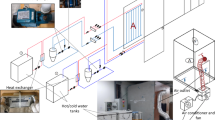Results of numerical modeling of the process of free-convective heat transfer in a turbulent convection regime in a rectangular enclosure heated by an infrared gas radiator are presented. A comparative analysis of two alternative locations of the infrared gas radiators in modeling of typical free-convective heat transfer regimes in the region is conducted. The essential nonstationary nature of the heat-transfer process and the influence of heat emission from the surface of the upper horizontal filler structure on the temperature patterns of zones of local heating of large work zones are established.


Similar content being viewed by others
References
V. B. Kuntysh, A. V. Samorodov, and A. N. Bessonnyi, “Experimental investigation of free-convective heat exchange of multi-series staggered beams from pipes with spiral aluminum ribs,” Khim. Neftegaz. Mashinostr., No. 3, 3–7 (2008).
M. Yu. Savinov and V. E. Poznyak, “An investigation of heat transfer in condenser-evaporators with intermediate cold carrier in plants for the production of krypton and xenon,” Khim. Neftegaz. Mashinostr., No. 12, 19–22 (2008).
Tiator and Ingolf, Heating Systems [Russian translation], Tekhnosfera, Moscow (2006).
A. L. Bulatov and E. V. Zagrebina, “Efficiency of the use of infrared gas radiators for heating production floor areas at the Magnitogorsk Metallurgical Combine,” AVOK, No. 2, 36–40 (2007).
G. V. Kuznetsov and M. A. Sheremet, “Mathematical modeling of complex heat transfer in a rectangular enclosure,” Tepolofiz. Aeromekh., 16, No. 1, 123–133 (2009).
G. V. Kuznetsov and M. A. Sheremet, “On one approach to mathematical modeling of the thermal regimes of radioelectronic instruments and electronic equipment,”Microelektronika, 37, No. 2, 150–158 (2008).
G. V. Kuznetsov and M. A. Sheremet, “Conjugate natural convection in an enclosure with local heat sources,” Comp. Thermal Sci., 1. 1, No. 3, 341–360 (2009).
G. V. Kuznetsov and M. A. Sheremet, “Two-dimensional problem of natural convection in a rectangular domain with local heating and heat-conducting boundaries of finite thickness,” Fluid Dynam., 41, No. 6, 881–890 (2006).
I. A. Belov and S. A. Isaev, Modeling Turbulent Flows Textbook, Baltic State Technical University, St. Petersburg (2001).
G. V. Kuznetsov and P. A. Strizhak, “Heat and mass transfer at the ignition of a liquid substance by a single “hot” particle,” J. Eng. Thermophys., 17, No. 3, 244–252 (2008).
G. V. Kuznetsov and P. A. Strizhak, “3D problem of heat and mass transfer at the ignition of a combustible liquid by a heated metal particle,” J. Eng. Thermophys., 18, No. 1, 72–79 (2009).
G. V. Kuznetsov and P. A. Strizhak, “The influence of heat transfer conditions at the hot particle–liquid fuel interface on the ignition characteristics,” J. Eng. Thermophys., 18, No. 2, 162–167 (2009).
The study was carried out with the financial support of a grant from the Russian Foundation for Basic Research (Project 14-08-00057).
Author information
Authors and Affiliations
Corresponding author
Additional information
Translated from Khimicheskoe i Neftegazovoe Mashinostroenie, No. 3, pp. 18−20, March, 2015.
Rights and permissions
About this article
Cite this article
Nagornova, T.A. Thermal Regimes of the Work Zones of Production Floor Areas Under the Conditions of Local Heating and Heat Dissipation Through an Upper Boundary. Chem Petrol Eng 51, 171–176 (2015). https://doi.org/10.1007/s10556-015-0019-y
Published:
Issue Date:
DOI: https://doi.org/10.1007/s10556-015-0019-y



